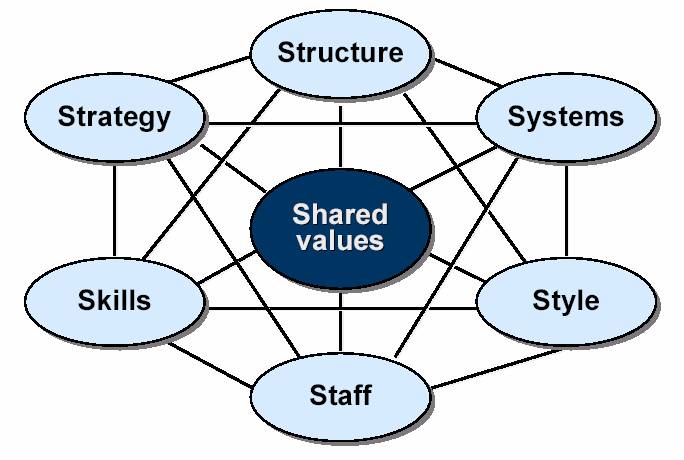 If you want to look at a framework for the purpose of change management and organizational development, you may want to study the 7-S framework. This is a model that describes how to organize to effectively organize and manage the various elements of an organization in an integrated manner. Consider this as just an introduction or maybe a reminder to get you on the road to further study and deliberation on the subject of change management
If you want to look at a framework for the purpose of change management and organizational development, you may want to study the 7-S framework. This is a model that describes how to organize to effectively organize and manage the various elements of an organization in an integrated manner. Consider this as just an introduction or maybe a reminder to get you on the road to further study and deliberation on the subject of change management
Shared Value – at the center of the model, this denotes what the organization stands for and what it believes in. This can also be referred to as the organization’s principle beliefs, values and attitudes
Strategy – this basically formulates how the organization’s resources will be deployed to reach key goals – this includes timescales, plans to cater for market and statutory change, plans to improve competitive advantage, and targets/strategies for enhancing service and customer orientation.
Structure – this describes how the organizational functions relate and inter-cooperate, now and in the future. Typical structures are centralized, functional divisions (top-down); decentralized (this is a top priority in fast-growing organizations that have to balance market growth with quality and service levels), matrix management, etc.
System – this assesses and analyzes the key organizational processes such as recruitment, performance management, financial systems, information management and so on
Staff – really about the number of people and their deployment as well as productivity measures
Style – Cultural style of the organization and how key managers behave in achieving the organization’s goals.
Skill – looking at the skillsets within the organizational as a whole and people skills. This analysis identifies core competencies
So what if you’re not a change management agent for a multinational but are simply looking to address your own organizational issues. Well, now you have a more formal way via the the 7-S framework to shape your thinking and focus your attention

Leave a Reply